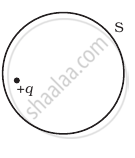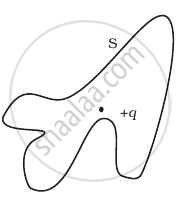Advertisements
Advertisements
प्रश्न
A thin conducting spherical shell of radius R has charge Q spread uniformly over its surface. Using Gauss’s law, derive an expression for an electric field at a point outside the shell.
उत्तर
According to Gauss law,
`epsi_0EointdA=q`
Where,
q is the point charge
E is electric field due to the point charge
dA is a small area on the Gaussian surface at any distance and
`epsi_0` is the proportionality constant
For a spherical shell at distance r from the point charge, the integral `ointdA` is merely the sum of all differential of dA on the sphere.
Therefore, `oint dA =4pir^2`
`epsi_0E(4pir^2) = q`
or `,E = q/(epsi4pir^2)`
Therefore, for a thin conducting spherical shell of radius R and charge Q, spread uniformly over its surface, the electric field at any point outside the shell is
`E = Q/(e_0 4pir^2)`
Where r is the distance of the point from the centre of the shell.
`E = q/(4piepsi_0r^2)`
APPEARS IN
संबंधित प्रश्न
State and explain Gauss’s law.
A charge ‘q’ is placed at the centre of a cube of side l. What is the electric flux passing through each face of the cube?
State Gauss’s law for magnetism. Explain its significance.
Answer the following question.
State Gauss's law for magnetism. Explain its significance.
Gaussian surface cannot pass through discrete charge because ____________.
Which of the following statements is not true about Gauss’s law?
The Electric flux through the surface
 (i) |
 (ii) |
 (iii) |
 (iv) |
Five charges q1, q2, q3, q4, and q5 are fixed at their positions as shown in figure. S is a Gaussian surface. The Gauss’s law is given by `oint_s E.ds = q/ε_0`
Which of the following statements is correct?
If `oint_s` E.dS = 0 over a surface, then ______.
- the electric field inside the surface and on it is zero.
- the electric field inside the surface is necessarily uniform.
- the number of flux lines entering the surface must be equal to the number of flux lines leaving it.
- all charges must necessarily be outside the surface.
The region between two concentric spheres of radii a < b contain volume charge density ρ(r) = `"c"/"r"`, where c is constant and r is radial- distanct from centre no figure needed. A point charge q is placed at the origin, r = 0. Value of c is in such a way for which the electric field in the region between the spheres is constant (i.e. independent of r). Find the value of c:
